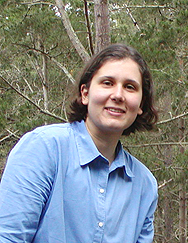|
May 31, 2004
Engineering alum applies computer science to
real estate
By Tim Stephens
It takes a few years for most college graduates to establish a career
and begin making a name for themselves.
|

Katherine Lebaric's software takes much of the guesswork out of
real estate pricing.
Photo by Louise Donahue
|
Not Katherine Lebaric. After graduating with honors from UCSC's Baskin
School of Engineering in 2002, Lebaric promptly launched her own company
based on software she had developed in her "spare time."
Lebaric's software, called RealNegotiate, is used to evaluate real
estate transactions and has been featured in Money magazine,
the Chicago Tribune, and Inman News, the leading real
estate news service.
Lebaric earned her B.S. degree in information systems management in
just three years. She was also on the UCSC swim team, but had to give
that up when she began taking upper-division classes.
"I had a very busy undergraduate career," she says.
She got the idea for RealNegotiate when her parents were thinking about
buying a house in the Monterey area. Deciding how much to offer for
a property is nerve-racking because a small difference in the sale price
can add up to a lot of money over the course of a 30-year mortgage.
Offer too little, though, and you risk being outbid by another buyer.
Real estate agents base their recommendations on comparative market
analyses--known as "comparables"--derived from recent sales
records for similar properties. But Lebaric felt that greater statistical
rigor could be brought to bear on the problem.
"You hear different things from different realtors, and it all
seemed very qualitative. I wanted something more quantitative,"
she says.
RealNegotiate takes the comparables data and feeds the numbers into
a statistical model, yielding quantitative answers to the kinds of questions
that buyers and sellers agonize over: How quickly will this property
sell at the listed price? What is the lowest offer I can make for this
house and still have a good chance of buying it? Should I accept this
low bid or hold out for more?
The software does this by generating a three-dimensional statistical
analysis that shows the inevitable trade-offs between three key parameters:
probability, price, and time. Probability is the likelihood of making
the sale (from the seller's point of view) or purchase (from the buyer's
point of view); price is how much the seller is asking or how much the
buyer offers; and time is how long the property stays on the market.
A seller can find out, for example, that at a given asking price the
property has a 75 percent probability of selling within the next 30
days, and if the price is lowered by $5,000 the probability of selling
would increase by 10 percent.
"It allows you to set your priorities in the context of the market,
so you can see how much to ask if you really have to sell within 30
days, or how long you're likely to wait if you hold out for a high price,"
Lebaric says. "It's an objective way to see the tradeoffs between
different factors."
In November, Lebaric demonstrated her software at the National Association
of Realtors Convention and Expo in San Francisco. Her modest booth attracted
a good crowd of interested realtors, even in the midst of flashy booths
from large companies featuring everything from free fruit baskets to
appearances by Fabio.
"I was doing demonstrations all day," says Lebaric, who at
22 was about half the age of most of those attending the convention.
"It was a pretty interesting experience."
That's when reporters started to call. The publicity has certainly
helped her business. While it isn't making her rich, she says her customers
include individuals, realtors, and real estate companies.
Lebaric earned a California real estate license last spring. She has
also been accepted to several prestigious graduate programs and plans
to begin studies in quantitative finance this fall.
According to Lebaric, this remarkable trajectory is all part of a plan
she had in mind before she even arrived at UCSC. She wanted to start
a business-related project while she was in school, and she also wanted
to graduate early.
"I came in with the idea that I would take very focused classes
and finish early but finish well," she says.
Her information systems management degree combines computer science
and business management economics. The engineering school describes
it as "a rigorous, challenging major" for students who want
to pursue a career of solving business problems through the use of information
technology.
But much of the computer programming skills Lebaric needed to create
the RealNegotiate software weren't covered in the courses required for
her major. So she picked those up on her own. For example, building
the GUI--the "graphical user interface" that gives the software
its look and feel--was a big project that required her to learn a new
set of programming tools.
At the same time that she was doing exemplary work in her courses,
Lebaric was also writing the product software, preparing patent applications
for the 50 or so patent-pending algorithms used in RealNegotiate, writing
the help documentation, and setting up the web site.
"It was kind of a hectic time," says Lebaric, whose energy
and enthusiasm suggest that she likes operating in high gear.
Lebaric's interest in business and finance started early. She remembers
checking out books from the library on subjects like "Introduction
to Stocks and Bonds" when she was still in grade school.
"It was fun because it related to the real world, like puzzles
with practical applications," she says.
Quantitative finance, which she will be studying in graduate school,
involves the application of statistics, mathematics, and computer science
to investments and finance. After graduate school, she plans to work
in the finance industry.
"Eventually, I'd like to run my own show in that area," Lebaric
says.
If past accomplishments are any indication, it won't take her long
to achieve that goal.
Return to Front Page
|